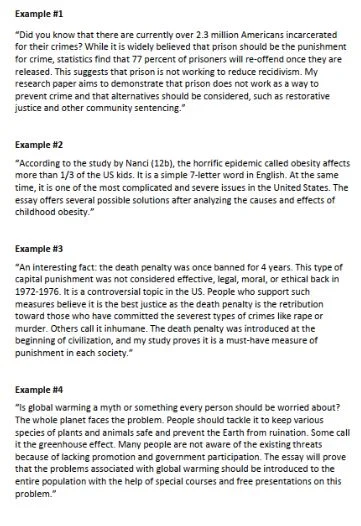How Many Paragraphs in a Research Paper: Steps on How to Write

A research paper is an essay where after exploring a particular topic thoroughly, you can write a detailed essay about it.
In as much as you are allowed to use your thoughts, opinions, ideas, and knowledge, you must also include information from sources, books, journals, internet sites, and interviews in your research.
Therefore, at least 80% of the research paper should be written in your own words. Paragraphs must be detailed and arranged in order to maintain the flow of the essay, with each explaining a new point or contribution.
How Many Body Paragraphs Should a Research Paper Have?
The number of body paragraphs in a research paper depends on the length of the research paper. Some instructors usually hand out a specific length for research papers.

With each paragraph containing five to six sentences, each page should have three paragraphs.
Therefore, a three-page research paper should have nine paragraphs, and a ten-page research paper should have at least 30 paragraphs.
However, some research papers may require longer paragraphs where two paragraphs are enough for every page. As such, a three-page essay and a ten-page essay should have six and twenty paragraphs, respectively.
The paragraphs should always be proportional to your paper length, with shorter paragraphs in short research papers and longer paragraphs in long research paragraphs.
Types of Paragraphs in a Research Paper
1. Introduction Paragraph
This is the paragraph where you set up the topic of the paper and the way you are approaching it to the reader. First, you have to introduce the topic. You have to tell the reader what you are writing about using a hooking sentence.
This sentence should grab the attention of the reader and convey the relevance of your topic. Secondly, you have to describe the background of the topic. This usually depends on the approach you are using in your paper and is mostly used in argumentative research.
It is where you review previous research and reveal how yours will fit in.
Thirdly is establishing your research problem. After showing how your research fits in, show the problems it addresses too.
Fourthly, you will have to specify the objectives of your paper. This is what you intend to find out and express in your paper.
Fifthly, you will have to include a brief overview of your paper. In a paper that uses the standard methods of research writing, it is not necessary, but if the structure is not predictable, it is important to describe it for the reader.
The last sentence in the introduction is always the thesis statement. It reveals everything the paper is all about.

2. Body Paragraphs
Arranging ideas and points in body paragraphs is a challenge for many students.
Each paragraph should always cover a different point. If two paragraphs have to explain the same thing, make sure that the approach taken in both is different.
To write a body paragraph, you will first start with a topic sentence to establish the main point of the paragraph. Reading the topic sentence in every body paragraph should provide the reader with the main points of your research.
The next task is unpacking the topic sentence. This is where you explain and discuss the individual parts of the topic sentence. After that, you give evidence to support your data. This is done by providing arguments, data, facts, figures, and quotations from credible sources.
Next, you will have to analyze the evidence. Never leave the evidence hanging. Instead, link it to the ideas you are trying to prove. Also, you will have to prove the objective by tying the body paragraph with the main topic of the research.
Finally, provide a transition to link your body paragraph to the next. The connection should be clear to maintain the flow of the paper.
3. Conclusion Paragraphs
This is the paragraph where you wrap up your thoughts and ideas and leave the reader with an impression.
The first thing to do when writing a conclusion is to remind the reader of your research problem. Paraphrase the research problem to make sure it is not identical to the one in the essay introduction.
Next, you will have to sum up the paper. Summarize what you addressed in the body of the essay and provide the conclusions they lead to. Generally, you have to summarize your overall findings.
After that, you discuss the implications. After formulating the summary of your findings, it is necessary to consider the implications of the broader research.
This is by providing the takeaways from your paper which are either practical or theoretical. For example, you can provide a reasonable call for action or suggest a research topic that is not covered in your paper.
How Many Paragraphs for Each of the Above Types?
Introduction paragraph
A research paper’s introduction paragraphs depend on the length of the paper. If you are writing a five-page page essay, then the introduction should not take more than half of a page.

Therefore, one or two paragraphs are enough for such a paper. However, when writing a longer essay, the introduction paragraphs should be more in order to introduce everything you will talk about in the essay.
There is always an approximation that the introduction should be 10 percent of the total word count.
If you are writing an 1800-word research paper, then the introduction should be at least 180 words which translates to two introduction paragraphs.
Body Paragraphs
The shortest research paper usually has five paragraphs. Therefore, you are supposed to have three body paragraphs and one each for the introduction and conclusion.
However, this varies depending on the length of the research paper. For example, an 1800-word research paper should at least have 16 body paragraphs.
Conclusion
Research papers should have one or two paragraphs that summarize everything that has been written in the paper. Making it too long may lead to repetition.
However, for longer essays, more paragraphs can be required to summarize the key findings and their significance. One can also use the 10% rule. A conclusion with 10% of the total word count is proportional to the essay length.
To add to that, professional empirical research articles usually have conclusions that range from five to six paragraphs.
On the other hand, novice and student research papers usually have two to three conclusion paragraphs.
How Long Should a Paragraph Be in a Research Paper?
The introduction paragraph of an essay should at least have five or six sentences that build up to the thesis statement at the end.

The first sentence should introduce the topic. The second should provide background information. The third should show the problem being addressed. The fourth should provide the objectives.
Lastly, the fifth should provide the overview, and the thesis statement should come last.
The body paragraphs of an essay should have six to seven sentences. These should contain sentences that introduce the main topic of the paragraph and unpack it.
Further sentences should provide evidence of the topic. Additionally, other sentences should analyze the evidence and prove the objective of the research paper. The last sentence should be a link to the body paragraph of the next
Lastly, the conclusion paragraphs should have five to six sentences. The average number of words should be between 75 to 85 words.
These paragraphs should not only be long enough to summarise your research paper but also short enough to avoid repetition of what is already written in the paper.
The sentences in the conclusion should be brief and straight to the point because there is nothing new that should be introduced. Every sentence should reflect the main idea of the essay.




